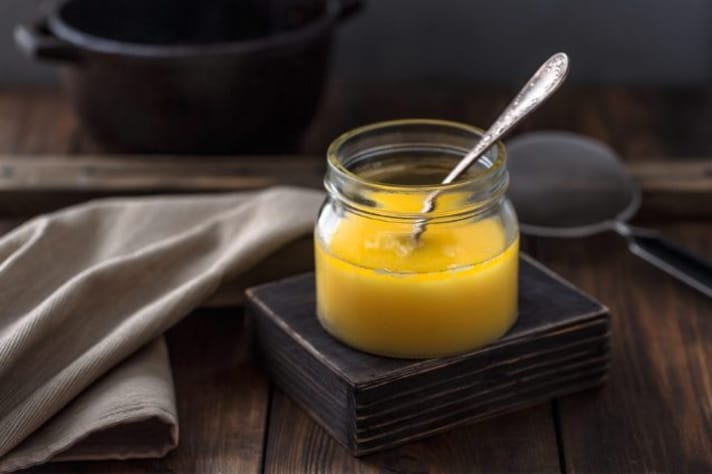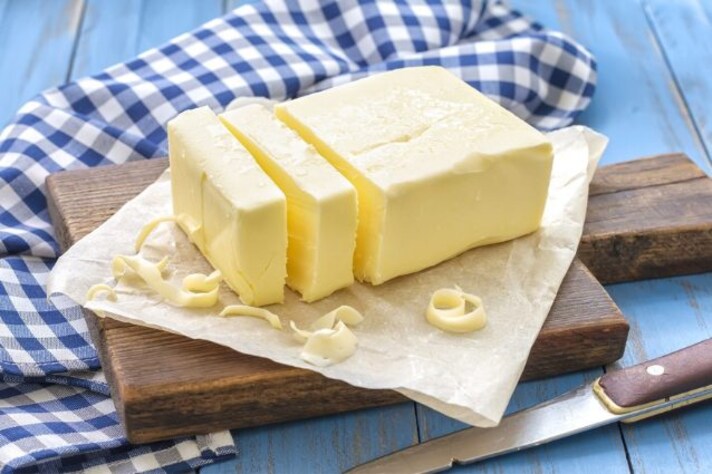
Clarified butter is an animal fat used for seasoning derived from the processing of butter, free of milk proteins and water. An ingredient of ancient Indian origins where it is the basis of many traditional dishes and used in Ayurvedic medicine because it is particularly digestible and has antioxidant properties. Perfect for frying because it cooks at a higher smoke point than simple butter, clarified butter provides a greater quantity of energy and saturated fats although, in small doses, it has no negative effects and is actually preferable to "classic" butter. Let's see what it is, how it differs from "normal" butter and how to use it in the kitchen.
What is Clarified Butter?
Clarified butter is a processed butter, deprived of water and casein. Deprived of the protein part, it becomes perfect especially for preparing golden fried foods thanks to its very high smoke point. More digestible than butter, clarified butter is very simple to prepare even at home and, taken in small doses, can have beneficial effects because it is composed mostly of short-chain saturated fats that the body assimilates in a similar way to carbohydrates. In Indian cuisine, clarified butter is called ghee and is the basis of numerous traditional recipes while in Ayurvedic medicine it is even considered a "miraculous" food for its digestive and antioxidant properties.

Clarified Butter Vs. Regular Butter
The differences between butter and clarified butter are essentially two: the chemical composition and the smoke point.
- "Normal" butter is made up of almost 80% fat, 15% water and the remainder of casein and lactose and provides approximately 758 kcal per 100 grams. Clarified butter is a "pure fat" that is healthier than simple butter, it is lactose-free, which goes away with water, and for this reason it is also recommended for those who suffer from intolerance; it contains saturated fats of which 60% are so-called "chain" fats (more easily digestible and assimilated) and provides approximately 900 kcal per 100 grams.
- Cooking: butter has a smoke point of around 248°F (120°C) while clarified butter melts at 360°F (180°C), making it perfect especially for frying and for particular types of preparations.
Compared to "classic" butter, clarified butter can be stored for a longer time, in the fridge, tightly closed in a glass jar.

How to Clarify Butter at Home
Making clarified butter at home is very simple. Break the butter into small pieces, put them in a pan and melt them in a bain-marie. A watery substance will rise to the surface as the butter melts: continue cooking over low heat until the watery part has completely evaporated, avoiding stirring. Take a funnel and sterile gauze and filter the clarified butter, being careful not to spill the bottom, where the casein has settled. Pour the butter into sterile jars and let it cool: when it has completely cooled it will also have solidified and will be ready for use.
What is Clarified Butter Used For in The Kitchen?
The main use of clarified butter in cooking is frying: the very high smoke point (about 360°F/180°C) in fact, allows this fat not to burn and to guarantee golden and crispy fried foods.
Frying but not only, because every rule has its exceptions: particularly loved in France, clarified butter is also used to prepare a refined béarnaise sauce or for fish meunière or, as they would say in Paris, a la meuniére. Clarified butter is ideal for browning meat because it promotes the Maillard reaction (the caramelization of sugars, the process that allows you to obtain a succulent crust) and for making the classic mirepoix, but also as a final creaming for risotto.
It is also perfect for simplifying the process of making béchamel sauce: the absence of water, in fact, simplifies the initial phase of preparing the sauce, avoiding the classic lumps that form when you make a roux without waiting for the butter to finish foaming completely.

;Resize,width=767;)
